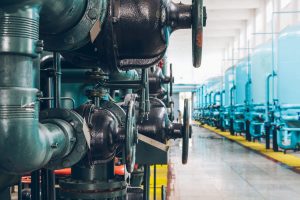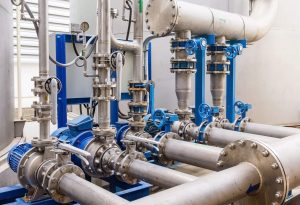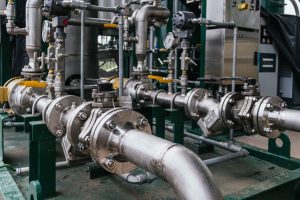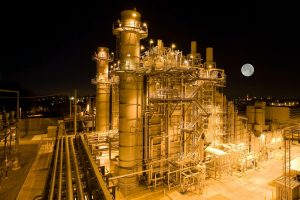The use of Hydroflo pumps and other water pumping systems is relatively standard across the majority of industrial and commercial facilities. However, in most circumstances, basic operations require the pumping of cold water, a natural lubricant for the pump system, and only low-pressure components.
When a company requires the pumping of hot water, it needs to address viscosity and vapor pressure changes. The differences between water at 68 degrees Fahrenheit and 176 degrees Fahrenheit seem minimal in measurement. Still, the composition of hot water makes it lighter and less lubricating while drastically increasing the system’s pressure because of vaporization. The changes only increase the increasing water temperature, which means that companies must understand how these changes affect the pumping system and what changes need to occur to prevent damage or early deterioration of pump components.
The Effect of Heat on Pumps

Most pump operators are familiar with the net positive suction head available for a specific pump. However, do not trust the stated NPSHA on specific vertical turbine pumps without first purchasing an NPSH test for the exact operating conditions. While a pump manufacturer may claim an NPSH, the numbers are not guaranteed without a confirmation test because of variation in uses and how depth and temperature can impact different pump components.
Hot water systems have an increased risk of cavitation, which is the rapid change in water pressure leading to metal wear. As liquid accelerates through the suction pipe, bubbles form as the pressure drops. The system forces the water from the line to the impeller eye. The pressure suddenly increases, forcing the bubbles to collapse, creating a tremendous amount of localized pressure and causing minor abrasions on the metal propeller. A stainless steel impeller has more resistance to these moments of cavitation.
Expansion and Pipe Components
The majority of centrifugal pumps can handle the temperature and water fluctuations of 250 degrees Fahrenheit. Still, as temperatures rise toward 300 degrees Fahrenheit, these systems struggle to keep up with the dramatic expansion. When working with temperatures above 250 degrees Fahrenheit, professional organizations recommend using Hydroflo pumps with centerline-supported casing.
Using systems with specialized casings allow for thermal expansion from its center of rotation. The allowance for expansion out from the center means that components maintain the same axis throughout the pressure and temperature changes. Because these systems are not fixed to the pump base vertically, pump owners experience fewer alignment problems than other casing designs.
The Necessity of Balance

For operations above 220 degrees Fahrenheit, a balanced seal is necessary for all pumps, even submersible turbine pumps. The balance ensures the proper operation at higher temperatures, but even correct seal usage is no match for temperatures above 250 degrees Fahrenheit. When reaching such temperatures, companies should consider Viton, Ethylene Propylene, Aflas, or Kalrez. However, while some of these materials will help balance the system, anytime water reaches above 250 degrees Fahrenheit, the system requires additional cooling. While a cooling jacket can help, a flush is better.
Avoiding Bearing Failure
Some pump operators worry about the bearings in hot water applications, but the added concern is unwarranted with most systems. The obsession with cooling the bearing frame can often cause the damage operators want to avoid. Excessive cooling can cause condensation and contamination of the lubricating oil, which leads to early bearing failure. To prevent such damage, only use precautionary cooling measures in operations over 500 degrees Fahrenheit.
The Importance of Pump Selection
Despite the increased concern for hot water pumping, the process is not complicated. Selecting the appropriate Hydroflo pumps, cooling system, mechanical seals, and pipes will ensure prolonged operations. When selecting and customizing your pumping solution, the primary consideration is water’s changing properties in increasing temperatures. Understanding the viscosity and pressure of heated water can prevent system failure, which equates to a safer work environment for all involved.
There is no need to decide on a pumping solution on your own. A Zone Industries representative can help you calculate your company’s needs, ensuring that the pump can handle your hot water operations. Instead of wondering about pump design specifications, contact Zone Industries to go over your system requirements, allowing experts to assess your process and needs. With a consultation and system assessment, you can be confident in the final installation and operation.
Understanding the Effects of Hot Water on a Pump System | Zone Industries
The process of industrial and commercial manufacturing requires the use of several different pumps, including AllFlo pumps. It is challenging to keep track of the various types of pump systems and applications. However, this article aims to identify 15 popular systems and provide a brief overview of each.
1. Centrifugal Pumps
A centrifugal pump has one or more impellers and is useful in many different applications. These pumps have the highest flow rates and can handle clean or dirty liquids. However, these devices will not work well for thicker liquids, like oil.
2. Regenerative Turbine Pumps
While a part of the same classification, regenerative turbine pumps are not considered a proper centrifugal pump. However, these models still use the same kinetic principle, but most are single stage. These devices’ best applications are small commercial boiler systems, like those found in dry cleaners or bakeries.
3. Submersible Pumps
If you require deep water or sewer operations, ask All-Flo Pump distributors about submersible pumps. These tools have an encased and protected motor with a single-stage pump, allowing the entire device to operate while submerged.
4. Vertical Turbine Pumps
A vertical turbine pump is versatile. While the design’s purpose is to operate in a bore-hole well, these sophisticated vertical shaft pumps can also pump from an intake structure, open reservoir, river, or tank. You can also use the pump as a booster pump mounted to the inside of a barrel.
5. Positive Displacement Pumps
While you can search for systems with the right All-Flo pump parts, you might find more luck working with a positive displacement pump. The positive displacement pump doesn’t rely on impellers to propel liquids through the system. Instead, it rotates or uses reciprocating parts to transfer materials.
6. Flexible Impeller Pump
A flexible impeller pump is likely what you need when a positive displacement pump is not enough and requires extra propulsion. The flexible impeller conforms to a displacement pump’s parts, allowing thin liquids’ easy transportation, even those containing some solids.
7. Piston Pumps
Piston pumps use pistons to create high pressure. These pumps provide adequate pressure for wash down services in oil production. Many people are familiar with these systems even if not aware of the name because they are used for pressure washing.
8. Lobe Pumps

When pumping viscous liquids containing soft or fragile liquids, lobe pumps provide the right amount of pressure. These pumps use two shafts to drive the lobes, which mesh but never touch, to pump the liquids gently. The food, beverage, and pharmaceutical industries find these devices most useful.
9. Gear Pumps
Like a lobe pump, a gear pump also uses two meshing gears, but the types are both internal and external. These pumps are not suitable for transporting abrasive liquids or those containing solids. The device is best for clean oils and other high viscosity liquids.
10. Diaphragm Pumps
Like some AllFlo pumps, diaphragm pumps use a reciprocating diaphragm driven by a fluid drive, solenoid, or mechanical drive. These tools also use inlet and outlet check valves. The diaphragm pump is useful in plants because of the varying materials it can handle, from those containing solids to corrosive substances.
11. AODD Pumps
If your pumping operation is not near electricity, then you may need to use air-operated systems instead. An AODD pump runs on air and is useful in construction projects, like concrete pouring.
12. Well Pumps

If you are more interested in rural operations, like irrigation, you may want to invest in a well pump. The well pump is a vertical turbine pump and is used in bore-hole applications.
13. Trash Pumps
A trash pump is a dewatering pump. It can be self-priming or submersible, and the design allows the unit to handle rocks and other solids. These pumps often find use in mining or construction operations.
14. Self-Priming Pumps
Self-priming pumps offer an advantage because they do not need to be submerged. These pumps have motors that rest above the reservoir and do not require external priming or foot valves.
15. Magnetic Drive Pumps
When looking for AllFlo pumps, consider the temperature and sealing issues of the substance. Magnetic drive pumps are sealless, which is advantageous when dealing with non-viscous or heat transfer fluids.
What type of pumping solution do you need? Contact a Zone Industries representative to discuss your business and operations.
Overview of 15 Popular Pumps, Including AllFlo Pumps | Zone Industries
Submersible pumps, such as those manufactured by HydroFlo Pumps, are an important component of many industrial applications. This guide from Zone Industries will walk you through the basics you need to know to determine if a submersible pump is right for your application.
What a Submersible Pump Is
Pumps are used to transport liquids from one place to another. All-Flo Pumps submersible pumps differ from other types of pumps because the pump and motor assembly are completely submerged in liquid. Submersible pumps can function while completely submerged because the motor is closely coupled to the pump body and hermetically sealed, forming a water-tight enclosure. Additionally, the enclosure around the motor is usually full of oil. This oil prevents liquid from getting inside the motor and causing a short circuit or other damage.
How a Submersible Pump Works
Because HydroFlo Pumps work by pushing liquid, instead of pulling, they operate very efficiently. The pump uses the head of liquid to do its work without expending any energy to draw fluid into the pump. The pump also saves energy by using the liquid it is submerged in to cool the pump and avoid overheating. The oil and gas industry frequently uses pumps that operate on the Electric Submersible Pumping principle. ESP motors can work under high pressure and temperatures. ESP motors are cost-effective at transporting large volumes of fluids from deep wells but can be expensive to run because of the special electricity cables they require.
Advantages of Submersible Pumps

Crane Pumps submersible pumps are self-priming. Because they run beneath the surface of the liquid being pumped, they do not require priming.
The head pressure of the liquid on the suction end of a submersible pump helps it operate. This makes the pump more efficient and causes it to use less energy, drawing in the fluid than some other types of pumps.
Centrifugal and other positive displacement pumps can be prone to cavitation. Because they are fully submerged, submersible pumps do not have this drawback.
The liquid submersible pumps are submerged in serves as a sound dampener. This makes submersible pumps less noisy than other types of pumps.
Submersible pumps are usually reliable, resist corrosion, and operate efficiently in harsh conditions. They are a good choice for applications that might quickly wear out less durable pumps.
Disadvantages of Submersible Pumps

Anything that is exposed to liquids for long periods will tend to corrode. Additionally, submersible pumps are frequently used to transport abrasive and corrosive liquids. Corrosion can damage the seals and cause leaks and other damage to the motor. Submersible pumps are made from materials that do not corrode easily. These materials cause submersible pumps to be more expensive than other similar pumps.
These pumps need to be inspected frequently so that repairs can be made and the pump’s life can be extended. However, inspections and regular maintenance are made more difficult to perform because many submersible pumps are difficult to access. For this reason, some companies choose to run the pumps until they break and then replace them, rather than maintaining them.
Uses for Submersible Pumps
Because HydroFlo Pumps are compact and inexpensive to install, they are often used in pump and lift stations. This makes these pumps popular choices in the wastewater and grit industry.
Harbors are often dredged with a pump designed specifically to handle liquids with high solid content, called a vertical pump. Seagoing ships also use these pumps for barge unloading and onboard flooding applications.
Grinder and other submersible pumps can be used to convert sewage material to easily handled particles. These pumps are capable of transporting sewage downstream for treatment without obstruction from entry to discharge.
The oil and gas industry often uses ESP submersible pumps to move oil to the surface from oil wells. The vertical turbine pump is frequently used in water wells and boreholes to transport water to the surface.
Choosing the Right Pump for Your Needs
HydroFlo Pumps can be a good choice for many applications that involve moving liquids that are corrosive or abrasive or contain a high level of solids. The team at Zone Industries can help you choose the right pump for your application. Call us at 713-783-8530 or fill out our online form to get more information or request a quote.
Guide to Submersible Pumps | Zone Industries
Submersible pumps, such as those manufactured by HydroFlo Pumps, have various benefits that make them ideal for commercial, residential, and industrial operations. Understanding what these pumps are and how they work is the first step towards choosing the best pump for the job you need. As a leader in the design, installation, and maintenance of pumps, Zone Industries will work with you to find the perfect solution for your needs.
What a Submersible Pump Is
Submersible pumps have airtight sealed motors that have several advantages for certain pumping applications. A high-quality submersible pump, such as Allflo Pumps, should never need to be taken out of the liquid it is submerged in. Because the liquid the pump is submerged in primes the pump, the pumps never need to be manually primed.
Uses for Submersible Pumps

Because HydroFlo Pumps are made to fit in difficult spaces, these pumps can be a good choice for places that are difficult to access or confined. These pumps are also good choices for wells. The ability to place the pump directly in the water source makes it easier to efficiently pump high-quality water into your home, worksite, or business. Additionally, these pumps are useful for draining fields, managing pond filtration, moving sewage and oil wells.
How Submersible Pumps Function
Submersible pumps, such as a vertical turbine pump, function by changing rotary energy into kinetic energy. The pump accomplishes this by using the pressure energy drawn in by the pump. The liquid enters the pump through the intake and is then pushed through the impeller and into the diffuser. After passing through the diffuser, the fluid can flow to the surface, where it can then be used for whatever purpose you need.
The hydraulic motors in these pumps are usually closed-cycle pumps but can also be open-cycle. Whether closed or open, the motors function similarly. These vertically positioned pumps can generate large amounts of pumping power.
Requirements To Use the Pumps
The pump will need to be submerged permanently; otherwise, it could overheat or sustain other damage. However, the issues are usually minor, so while it is a good idea to keep the pump submerged, you do not need to go to extremes to submerge your vertical pump.
Advantages of Submersible Pumps

To get maximum benefits from a submersible pump, it is wise to choose a manufacturer known for high-quality pumps, such as Crane Pumps. Top-quality pumps have numerous advantages:
- These pumps do not use very much energy compared to other similar pumps. Because of this energy efficiency, submersible pumps are a good choice for budget-conscious homeowners and businesses
- Because you do not need to prime these pumps, they are lower maintenance and easier to operate than other types of pumps
- These pumps do not experience cavitation or spikes in pump pressure. Additionally, because they are submerged, the liquid serves as a sound barrier, making these pumps very quiet to operate
- If you have a lot of different jobs to be done, these pumps are a good choice because of their versatility
Disadvantages of Submersible Pumps
We believe that these pumps’ advantages outweigh the disadvantages, but it is still important to be aware of potential drawbacks. There are a few limitations you should consider when choosing a pump:
- While these pumps are useful in many different applications, they are not the best choice for every job. Your Zone Industries representative can help you determine whether a submersible pump is a good fit for the job you need to do
- Because the pumps are constantly exposed to liquids, some of which may be corrosive, the seals can break down, which may lead to damage to the motor
- The liquid surrounding the pump usually keeps the pump cool, but if the liquid dries up, your pump could overheat. You may need to be cautious when using these pumps in wells or other applications where there is a significant danger of the liquid drying up
Work With a Pro
Choosing the right pump for your job will help you avoid costly repair or replacement issues. Whether you choose HydroFlo Pumps or one of the other product lines we carry, the team at Zone Industries has the expertise and experience needed to help you purchase the right equipment for your job. Give us a call at 713-783-8530 or contact us online for information or a quote.
What Is a Submersible Pump and Why Should You Use One? | Zone Industries
When discussing Hydroflo Pumps, most business owners understand that you are talking about one of the most dependable manufacturers on the market. The company specializes in centrifugal pumps, but more specifically, submersible and vertical turbine pumps. These pumps are useful tools in several manufacturing or producing markets, like farming, mining, and other industrial models. Beyond commercial production, turbine pumps are helpful in municipal applications as well.
Vertical pumps tend to work better in specific settings, but it isn’t easy to know if it suits your needs without understanding the pump. To get the most use out of a vertical pump, you need to understand the intent of the design and its mechanics. The remainder of this article will help inform your future purchasing decision.
Defining the Vertical Turbine Pump
The centrifugal pump known as the vertical pump, deep well, or lineshaft pump, transports water from underground wells and reservoirs. While submersible turbine pumps are also useful in this regard, a vertical pump is often more practical because of its design. The primary difference between a submersible and a vertical pump is the placement of the motor. Submersible systems have the motor housing on the bottom of the pump, which is then placed in the water. While the housing is waterproof, damage can occur, especially when pumping from deeper water sources.
The vertical turbine pump, alternatively, has the motor mounted above ground, which is then connected to the impellers through a long vertical shaft. The design of the vertical system means that the engine remains dry and free of potential risk, which is why many deep well operators prefer to use the vertical structure. The mechanics of the system also make the vertical pump more customizable than other options on the market, which is another plus for business owners.
Learning How It Works
The vertical turbine systems through Hydroflo Pumps are versatile and customizable. Depending on your needs, you can choose a diesel engine that drives the system through an angled drive, or you can opt for an AC electric induction motor. Beyond engine selection, you can also choose the number of impellers for your system. While every vertical propeller requires at least one rotating propeller to direct water into the bowl or diffuser casing, the number of propellers above that casing is up to the owner.
The impellers work to build water velocity and pressure, helping to propel the liquid from the bottom of a well through the system. The first propeller increases the speed by forcing the water through the suction bell at the base of the pump. The water then enters the diffuser bowl, where velocity energy is transformed into high pressure and directed up the shaft. Depending on the well depth, multiple propellers can help to build more velocity and pressure.
Beyond the impellers and the diffuser bowl, the system uses a spinning shaft to help move water from the pump to the discharge head. The motor, above the discharge head, helps to create the necessary momentum to change the flow direction, pointing it to the discharge pipe.
Understanding the Uses
Companies and municipal services tend to use vertical pumps when submersible pumps are not an option because of flow demands. However, motor placement can also play a role. Some common examples where a vertical pump is more beneficial than a submersible pump would be with bored wells for turf and agricultural irrigation. Industrial plants may also use vertical systems for make-up or fire water demands. Finally, a municipality dependent on groundwater rather than surface water will likely use a vertical pump.
Beyond specific needs, many companies choose vertical pump options because of the versatility of the system. For example, these systems are capable of pumping 50 GPM to 30,000 GPM or higher. Also, the customization and options for multiple stages to generate greater head is often preferable. Companies also appreciate the various placement options for a vertical system: bored wells, open water sources, and even inside barrels. A business can place these pumps in reservoirs, rivers, and other intake structures. By putting it inside a barrel, the operator can increase or decrease the atmospheric pressure of the suction source. Few pumps allow such flexibility.
The vertical turbine systems from Hydroflo Pumps are a versatile setup for specific entities. After learning about the design, purpose, and mechanics of the vertical pump system, it should be easier to decide whether it is right for your needs. If you are still having difficulty choosing a centrifugal pump for your business, then consider contacting a Zone Industries representative for more information. They can learn more about your operations to help pinpoint your company’s specific pumping needs, and can weigh the pros and cons of each pump type with you to find the best option.
How Does a Vertical Pump From Hydroflo Pumps Work? | Zone Industries


